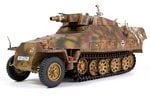davebender
1st Lieutenant
le. Zgkw. 3t
1935. 1 Prototype. HL.kl.3 (H). 3.7cm main gun in rotating turret.
1936. 1 Prototype. Hl.kl.4 (H). 7.5cm main gun in rotating turret.
1937 to 1939. 30 prototypes. Hanomag H8 (H).
.....Engine moved to rear for all 3 prototypes.
.....11mm to 20mm armor.

Why didn't the German Army complete development and put these or similiar Sd.Kfz.11 chassis tracked fighting vehicles into mass production? More powerful and less expensive then the Panzer II ausf C. Suspension is better too. Or you could go a size larger by using the Sd. Kfz. 7 chassis which was fully developed and in mass production during 1937.
1935. 1 Prototype. HL.kl.3 (H). 3.7cm main gun in rotating turret.
1936. 1 Prototype. Hl.kl.4 (H). 7.5cm main gun in rotating turret.
1937 to 1939. 30 prototypes. Hanomag H8 (H).
.....Engine moved to rear for all 3 prototypes.
.....11mm to 20mm armor.
Why didn't the German Army complete development and put these or similiar Sd.Kfz.11 chassis tracked fighting vehicles into mass production? More powerful and less expensive then the Panzer II ausf C. Suspension is better too. Or you could go a size larger by using the Sd. Kfz. 7 chassis which was fully developed and in mass production during 1937.


